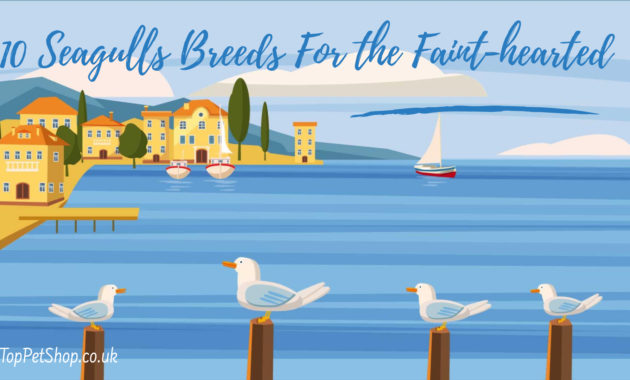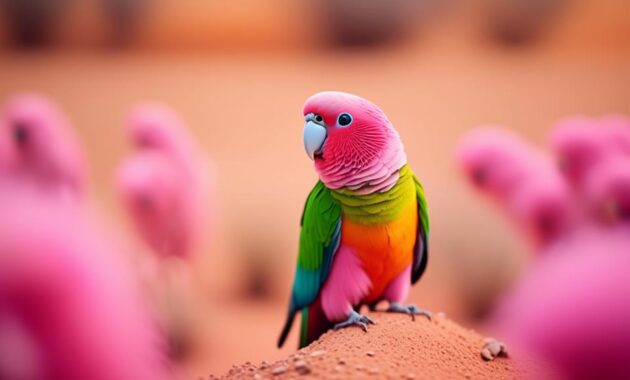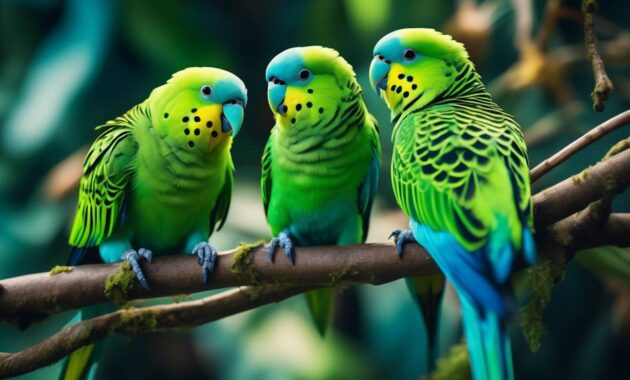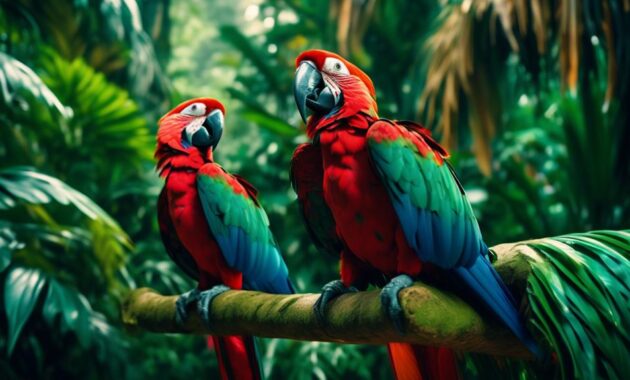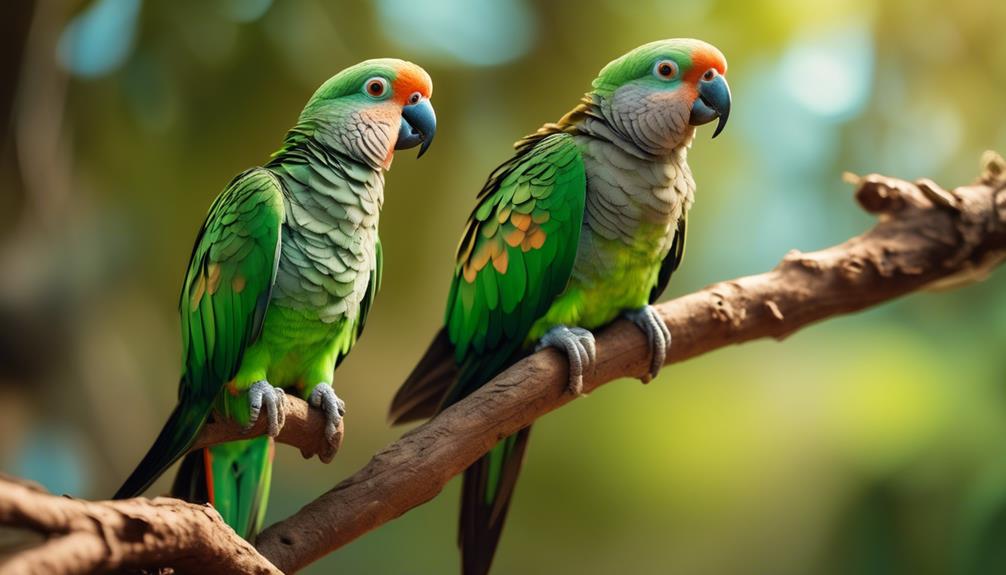
Are you hesitant about welcoming a pet bird into your home? Worried about the noise, mess, or lack of companionship?
Well, let us introduce you to the majestic Cape Parrot, a pet bird that will shatter all your preconceptions. This stunning creature is not only social and intelligent but also vibrantly colored, making it a captivating addition to any household.
But that’s just the beginning! There’s so much more to discover about the Cape Parrot, from its physical characteristics to its talking abilities and overall care.
So, if you’re ready to uncover the secrets of this extraordinary bird, prepare to be amazed as we take you on a journey into the enchanting world of the Cape Parrot.
Key Takeaways
- Cape parrots are medium-sized birds, measuring about 13 inches in length and weighing between 10 to 14 ounces. They have a muscular build and short tails with rounded wings.
- The dominant color of Cape parrots is green, with gray heads, napes, and chests, and brown speckles. They have black upper wings with a bright orange front edge and gray flight feathers. They also have two orange bands on their ankles.
- Cape parrots have a lifespan of 40-60 years and are known for their strong and sturdy health, with low chances of skin and feather diseases. However, basic care, interaction, and exercise are important for their overall well-being.
- Cape parrots are social and affectionate birds with good talking ability and high intelligence. They make great pets and companions, and can adapt well to apartment living as long as they have enough space to move around.
Physical Characteristics
Cape parrots are medium-sized birds known for their vibrant green plumage and distinctive orange accents. They measure around 13 inches long and weigh between 10 to 14 ounces. With a muscular build, short tails, and rounded wings like African Grey parrots, they’ve a unique appearance.
Females have a single orange patch on their foreheads, adding to their charm. The dominant color of Cape parrots is green, with gray heads, napes, and chests adorned with brown speckles. Their upper wings are black with a bright orange front edge, while their flight feathers are gray. These magnificent birds also have two orange bands on their ankles, making them truly eye-catching.
Lifespan and Health
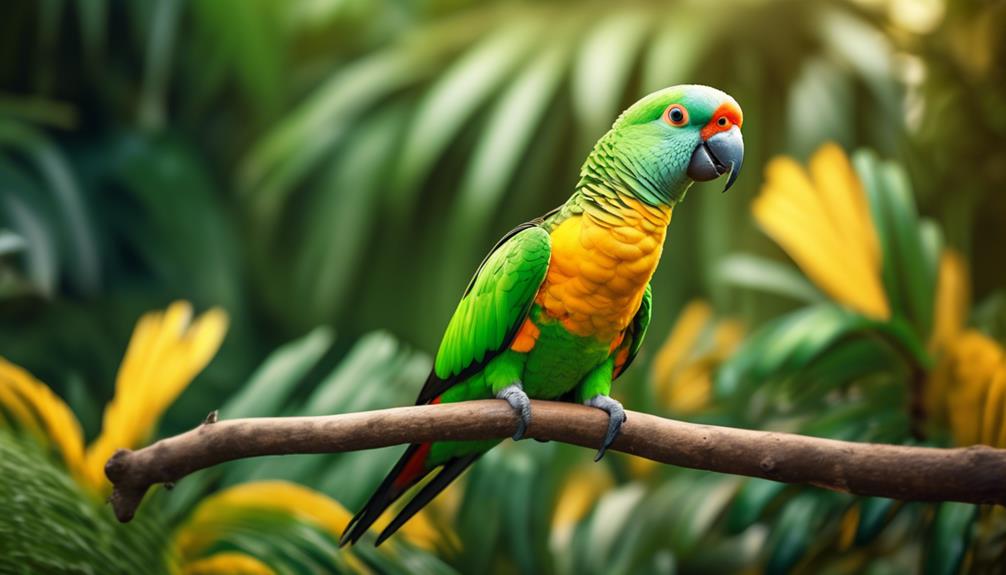
With an average lifespan ranging from 40 to 60 years, Cape parrots are known for their longevity and robust health. These majestic birds have the lowest chances of skin and feather diseases, making them a great choice for pet owners looking for a healthy companion.
However, it’s important to provide them with basic care, interaction, and exercise to ensure their overall well-being. Due to their large size and wingspan, Cape parrots require a lot of space to thrive.
Their strong and sturdy health is a testament to their natural resilience. So, if you’re considering adding a Cape parrot to your family, rest assured that you’ll have a feathered friend that will be with you for many years to come.
Sounds and Environment
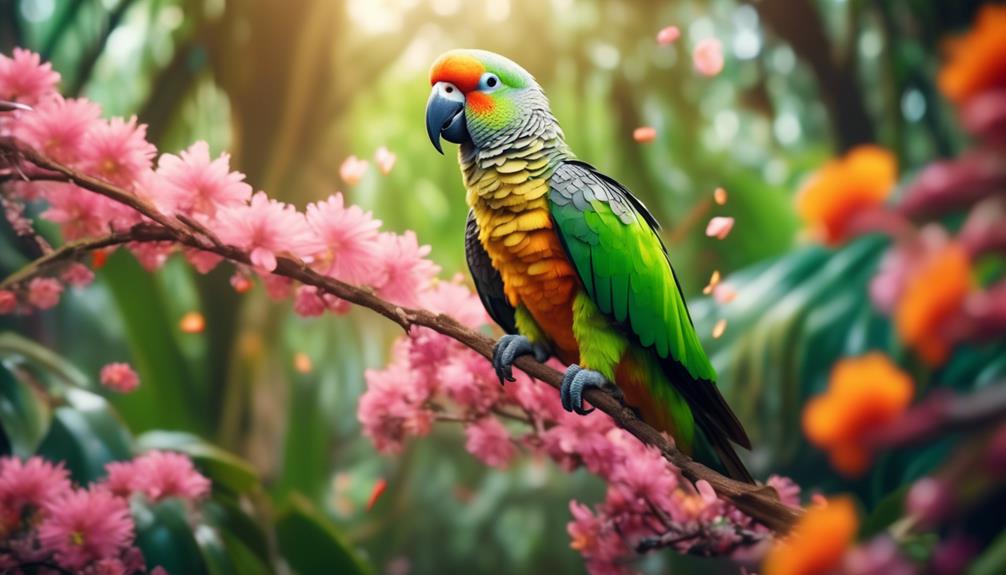
To create a harmonious environment for your Cape parrot, it’s important to understand their sounds and space requirements.
Cape parrots are great talkers, similar to African Greys, and have loud natural calls. However, they’re generally calm and suitable for apartment settings. They can be content with chatting quietly or with their owners.
In terms of space, Cape parrots require a lot of it due to their large size and wingspan. They need room to stretch their wings and exercise. Make sure to provide them with a spacious cage and plenty of out-of-cage time to fly and explore.
Social and Intelligent Nature
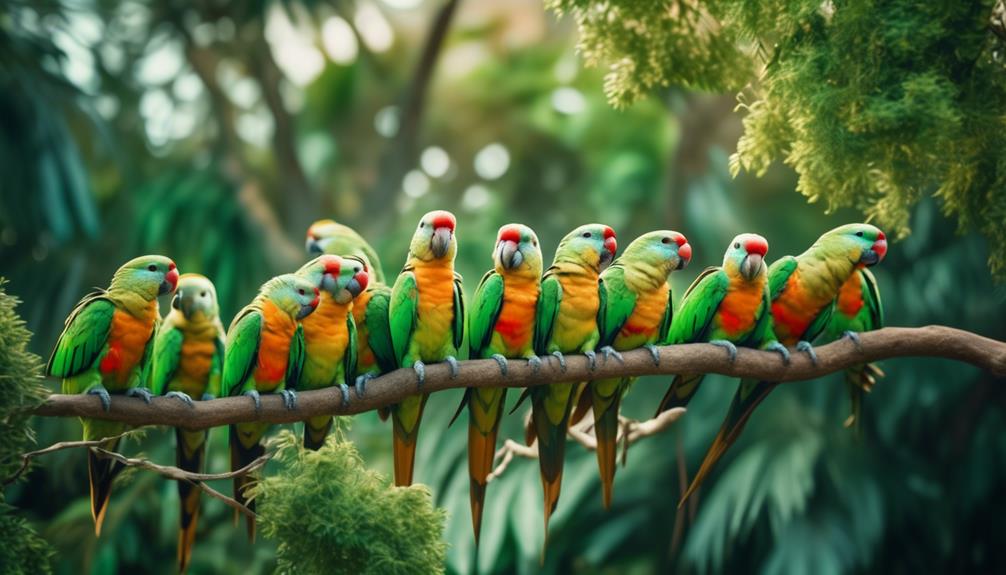
Interacting with a Cape parrot will reveal their social and intelligent nature. These birds aren’t only fun and affectionate, but they’re also highly intelligent creatures. They make great pets and friends, as they’re known for their cuddly and gentle nature.
Cape parrots have good talking ability and possess big intelligence. They can learn tricks and mimic speech with ease. You’ll be amazed by their ability to problem-solve and their eagerness to learn new things.
These birds thrive on social interaction, and they enjoy spending time with their owners. They’ll bond closely with you and become an integral part of your family. If you’re looking for a pet that offers companionship and mental stimulation, the Cape parrot is an excellent choice.
Overall Care and Feeding
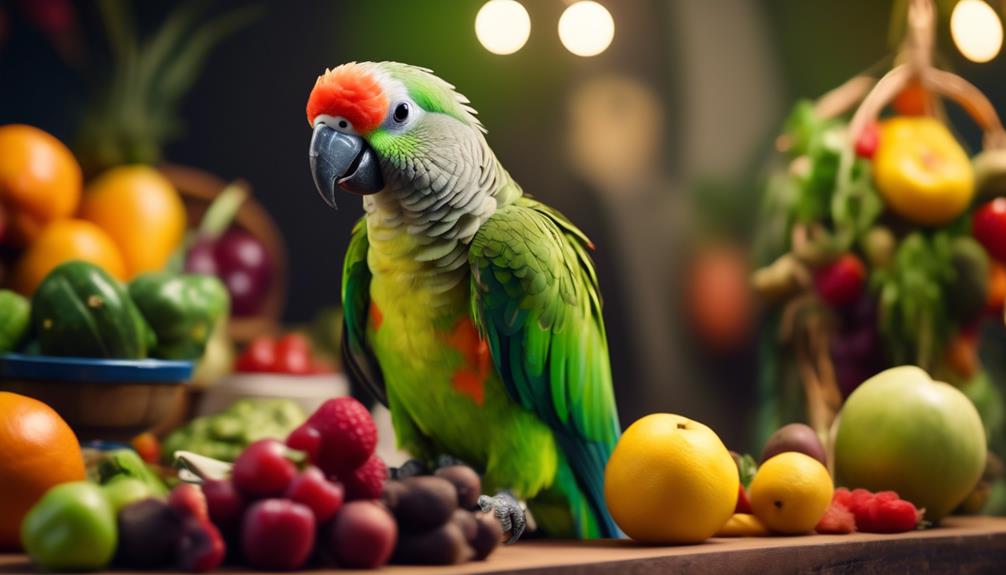
If you’re considering getting a Cape parrot as a pet, it’s important to understand the overall care and feeding requirements for these social and intelligent birds. Here are some key points to keep in mind:
- Provide ample space: Cape parrots have a large size and wingspan, so they need plenty of room to move and thrive.
- Offer interaction and exercise: These birds are social and affectionate, so make sure to spend quality time with them and provide opportunities for exercise to keep them happy and healthy.
- Attend to their overall well-being: While Cape parrots have strong and sturdy health, they still require attention and care. Regular check-ups with a avian veterinarian are recommended.
- Create a suitable environment: Ensure that their living space is spacious, comfortable, and stimulating to cater to their needs.
- Feed a balanced diet: While specific details about feeding weren’t mentioned, it’s important to provide a variety of fresh fruits, vegetables, seeds, and pellets to meet their nutritional needs.
Size and Weight
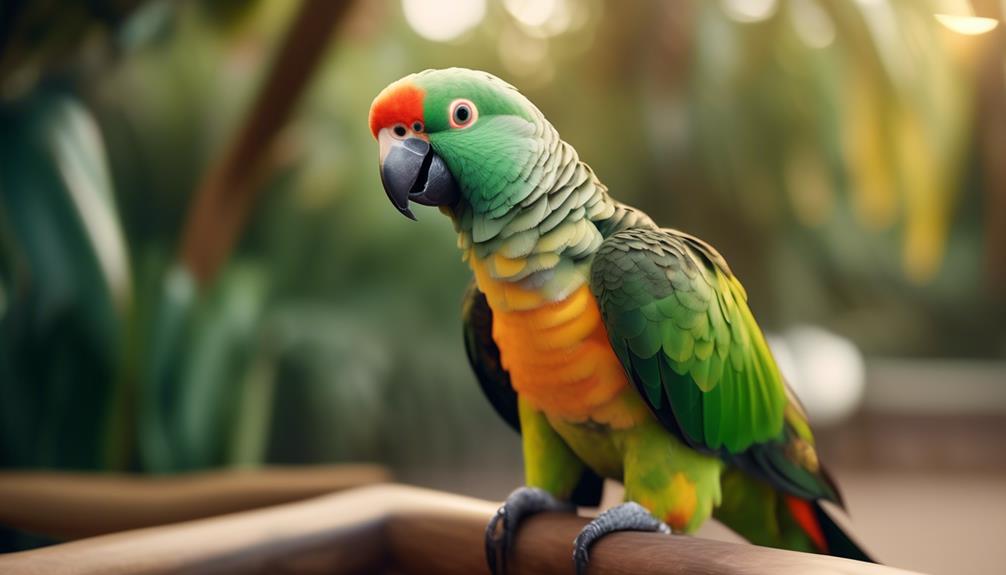
Cape parrots are a medium-sized pet bird, measuring approximately 13 inches in length and weighing 10 to 14 ounces. These dimensions make them a great choice for those looking for a pet bird that isn’t too small or too large.
With their muscular build and short tails, Cape parrots resemble African Grey parrots. Their rounded wings allow for graceful flight. The females have a distinctive single orange patch on their foreheads.
Despite their medium size, Cape parrots are still vibrant and eye-catching with their green bodies, gray heads, and brown speckles. Their upper wings are black with a bright orange front edge, and they’ve two orange bands on their ankles.
Colors and Markings
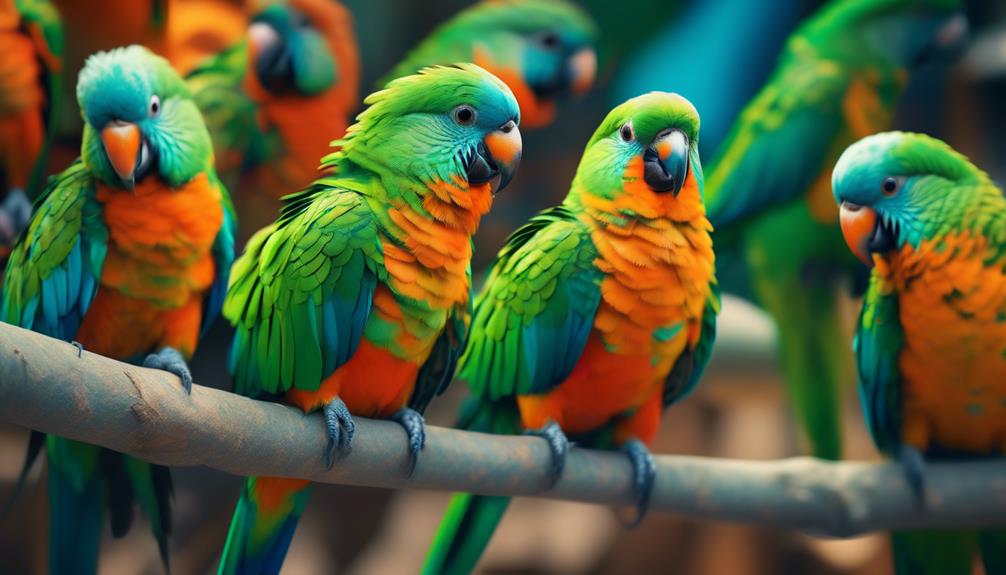
The vibrant colors and distinctive markings of Cape parrots make them truly captivating pets. When you bring a Cape parrot into your home, you’ll be mesmerized by their stunning appearance. Here are some of the colors and markings that make them so unique:
- Dominant Color: The Cape parrot’s dominant color is green, giving them a beautiful natural look.
- Gray Features: They’ve gray heads, napes, and chests with brown speckles, adding a touch of elegance to their appearance.
- Orange Accents: The upper wings of Cape parrots are black with a bright orange front edge, creating a striking contrast against the green feathers.
- Ankle Bands: These parrots also have two orange bands on their ankles, adding a pop of color to their overall look.
- Forehead Patch: Females have a single orange patch on their forehead, distinguishing them from males.
With their vibrant colors and unique markings, Cape parrots are sure to be a standout addition to your home.
Talkative Abilities
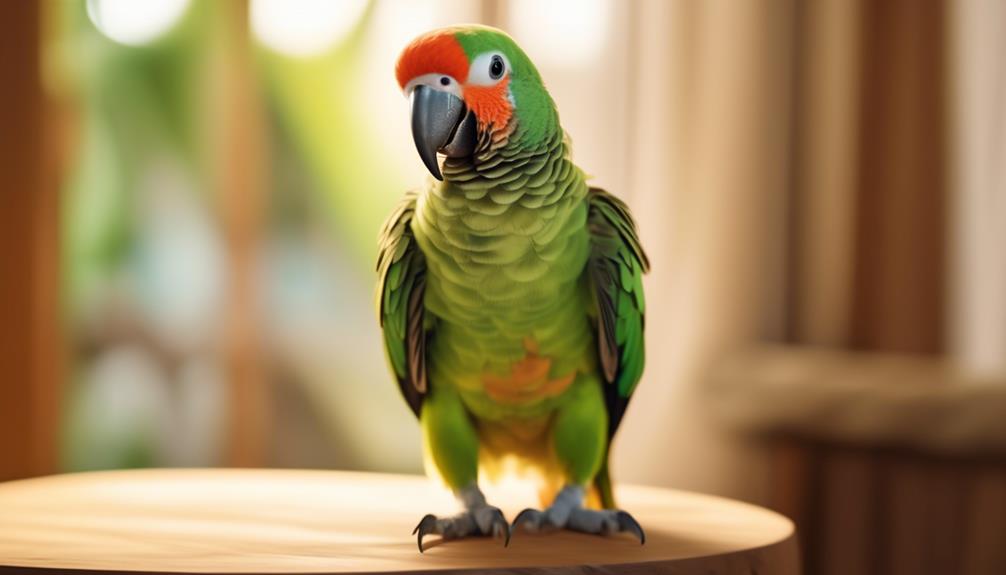
With their social nature and intelligence, Cape parrots are known for their impressive talkative abilities. Similar to African Greys, they’re great talkers and can mimic a wide range of sounds and words. Cape parrots have a natural talent for learning and imitating human speech, making them excellent companions for those seeking a bird with expressive communication skills.
They’ve a clear and distinct voice, and their talking abilities can provide hours of entertainment and interaction for both themselves and their owners. It’s important to provide them with a stimulating environment and regular social interaction to encourage their vocal development.
With patience and consistent training, Cape parrots can become skilled talkers, adding a delightful and engaging element to your daily life.
Space Requirements
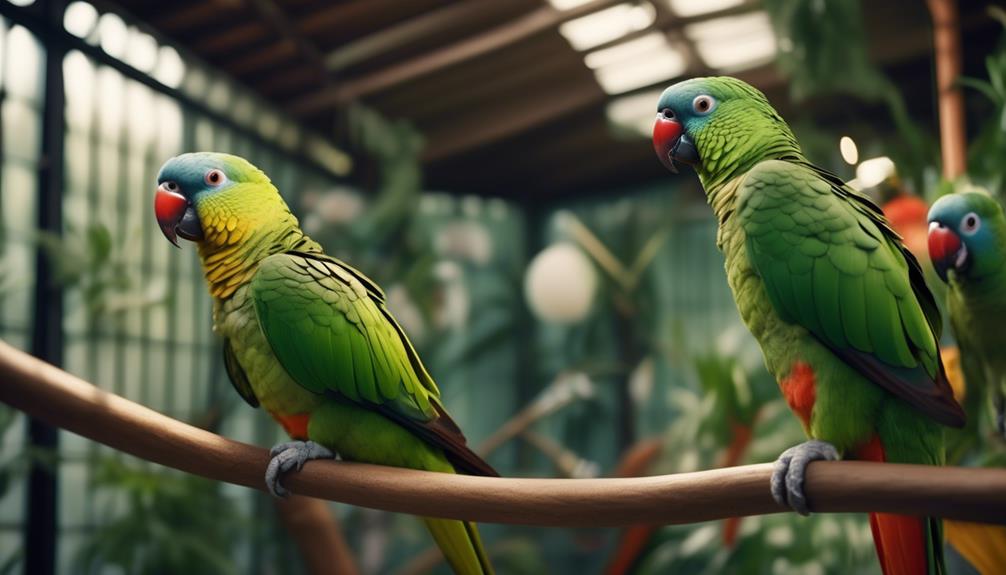
To accommodate their large size and wingspan, Cape parrots need ample space to thrive and move freely. Here are five key points to consider regarding their space requirements:
- Cage Size: Provide a spacious cage that allows the Cape parrot to fully extend its wings and move around comfortably. A minimum cage size of 3 feet by 3 feet is recommended.
- Perches: Include multiple perches of varying sizes and textures to promote foot health and exercise. Natural branches are ideal as they mimic the parrot’s natural environment.
- Flying Space: Cape parrots require regular exercise and mental stimulation. Set aside a safe, supervised area where they can stretch their wings and fly around.
- Playtime: Engage in interactive play sessions outside the cage to fulfill their need for social interaction. Offer toys and puzzles to keep them mentally stimulated.
- Environmental Enrichment: Create a stimulating environment with toys, foraging opportunities, and different textures to keep Cape parrots entertained and prevent boredom.
Frequently Asked Questions
What Is the Average Size and Weight of a Cape Parrot?
The average size and weight of a Cape parrot is approximately 13 inches long and 10 to 14 ounces. They have a muscular build, short tails, and rounded wings similar to African Grey parrots.
What Are the Specific Colors and Markings of a Cape Parrot?
Cape parrots have green feathers with gray heads, napes, and chests. They also have brown speckles and black upper wings. Their flight feathers are gray, and they have two orange bands on their ankles.
Do Cape Parrots Have Any Unique Talkative Abilities?
Cape parrots have unique talkative abilities. They are great talkers, similar to African Greys. With their intelligence and good talking ability, they can be content chatting quietly or engaging in conversations with their owners.
How Much Space Do Cape Parrots Require in Their Environment?
Cape parrots require a lot of space in their environment due to their large size and wingspan. They have a muscular build and thrive when they have enough room to move around and exercise.
What Is the Recommended Diet for Cape Parrots?
The recommended diet for Cape parrots includes a variety of fresh fruits, vegetables, nuts, and high-quality pellets. It’s important to provide a balanced diet to ensure their overall health and well-being.
What Are the Similarities and Differences Between Cape Parrots and Sun Conures as Pet Birds?
Cape parrots and sun conures as pet birds have notable differences. While the playful sun conures originate from Brazil and are known for their vibrant colors and sociable nature, Cape parrots are more reserved and hail from South Africa. Both birds require dedicated care and attention, but their personalities and origins vary.
Conclusion
In conclusion, the Cape Parrot is a remarkable pet bird that will bring joy and companionship into your life. With its vibrant colors, intelligence, and affectionate nature, it’s truly a majestic creature.
From their physical characteristics to their social and intelligent nature, Cape Parrots are a delight to have as pets. With proper care and feeding, they can live a long and healthy life, providing you with years of happiness and love.

